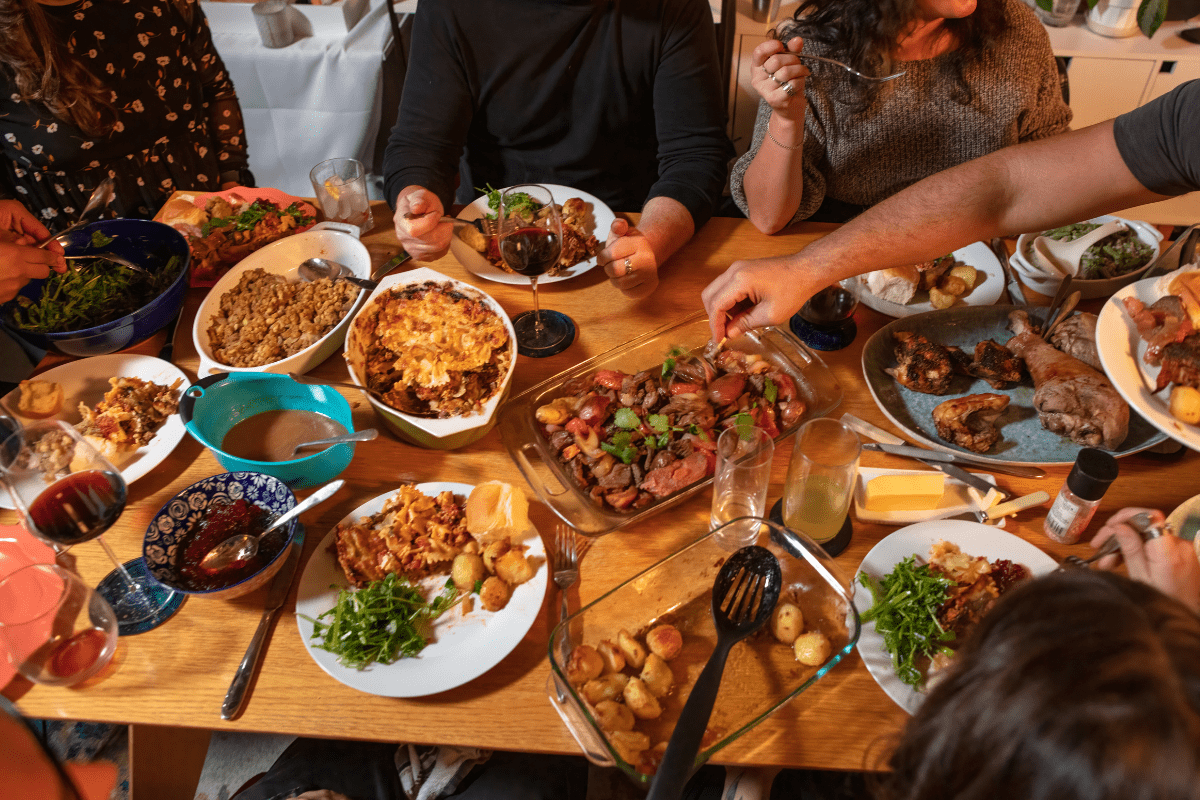When most people think of Iowa, they picture endless cornfields and maybe a few pigs. But this agricultural powerhouse has quietly developed one of America's most distinctive regional cuisines, where German grandmas' recipes meet county fair innovation and portions that make Texas jealous.
From sandwiches that require a fork to eat properly to festivals celebrating everything from sweet corn to sauerkraut, Iowa's food scene tells the story of a state that takes its eating seriously.
The holy trinity of Iowa sandwiches
Iowa has mastered the art of the sandwich in ways that confuse and delight outsiders. These aren't your standard deli creations; they're edible monuments to Midwestern ingenuity and agricultural abundance.
The legendary loose meat sandwich
In 1926, Muscatine butcher Fred Angell created what might be Iowa's greatest contribution to American cuisine. When a deliveryman tasted his latest experiment and declared "This sandwich is made right," the Maid-Rite was born. Unlike a hamburger, this sandwich features 100% choice beef ground fresh daily that's simmered rather than fried, creating a crumbly texture that defies physics and frequently ends up in your lap.
The preparation is deceptively simple but fiercely protected. The meat cooks in special steamers visible to customers, served on a steamed bun with mustard, onions, and pickles. No ketchup allowed – that's practically sacrilege. Taylor's Maid-Rite in Marshalltown, purchased by Cliff Taylor in 1928 for $300, still follows the original methods, even grinding their beef daily and serving homemade ice cream from Taylor's original recipe.
Today, 19 of the 30 Maid-Rite locations nationwide operate in Iowa, making it what locals call "Iowa's rite of passage." The sandwich gained unexpected fame in the 1989 film "Field of Dreams," though Kevin Costner probably should have asked for extra napkins.
Not to be outdone, Canteen Lunch in the Alley in Ottumwa has served its own version since 1927. This horseshoe-shaped counter with just 17 stools prepares 100-150 pounds of specially ground beef daily in cast iron steamers. The restaurant inspired the Lanford Lunch Box in the TV series "Roseanne," bringing Iowa's loose meat tradition to primetime television. Their version comes wrapped in signature wax paper, paired with homemade pies and malts that make the inevitable shirt stains worth it.
The pork tenderloin that ate Manhattan
If the loose meat sandwich is Iowa's subtle contribution to sandwich culture, the pork tenderloin is its rebel yell. While Indiana technically invented the breaded tenderloin in 1904, Iowa transformed it into something that defies both logic and standard-sized plates. These sandwiches feature breaded pork extending far beyond the bun's borders, sometimes "as wide as a dinner plate".
This supersizing makes perfect sense in a state that produces one-third of America's pork, with 24 million pigs being raised at any given time across 5,400 farms. The industry contributes $13.1 billion to Iowa's economy and provides jobs for one in ten working Iowans, making this sandwich both a culinary icon and economic powerhouse.
The preparation involves taking boneless pork loin chops (not actual tenderloin, despite the name), pounding them mercilessly thin, hand-breading them, and deep-frying to golden perfection. The Iowa Pork Producers Association even hosts an annual contest to crown the state's best tenderloin, with winners displaying their certificates like Olympic medals.
Traditional accompaniments include:
- Lettuce and tomato
- Raw onion rings
- Dill pickle slices
- Yellow mustard only
- Mayo for newcomers
- Cheese for rebels
- Prayers for clean shirts
Ham balls: The potluck powerhouse
If you've never heard of ham balls, you've clearly never been to an Iowa church supper. These uniquely Midwestern creations combine ground ham with ground beef or pork, bound with graham cracker crumbs (never breadcrumbs – that's important), eggs, and milk. The mixture gets formed into balls and baked with a sweet-tangy glaze of tomato soup, brown sugar, vinegar, and mustard.
Food historian Darcy Dougherty Maulsby calls them "the perfect Iowa potluck treat," and she's not wrong. The dish emerged from German and Danish immigrant communities and gained prominence during the mid-20th century when every Iowa church cookbook included at least three ham ball recipes, each claiming to be slightly better than the others.
During RAGBRAI (Register's Annual Great Bicycle Ride Across Iowa), towns along the route compete to serve the best ham balls to thousands of hungry cyclists. They're often paired with cheesy hashbrown casserole in a combination that defines Iowa comfort food and ensures nobody's riding very fast afterward.
Sweet corn and agricultural abundance
Iowa's relationship with corn borders on the sacred. The state has led the nation in corn production for over 150 years, growing 2.63 billion bushels in 2024 from 12.5 million acres. While 99% goes to ethanol, livestock feed, and processed foods, that remaining 1% of sweet corn holds outsized cultural importance.
The cult of sweet corn
The preferred variety is a bicolor type called "Peaches and Cream," and locals will tell you with straight faces that corn from other regions "tastes like plastic in comparison." They might be onto something – Iowa's long warm seasons, rich soil, and adequate rainfall create ideal growing conditions.
Sweet corn season runs from July through August, marked by roadside stands that pop up faster than the corn itself. Traditional preparation remains admirably simple: exactly five minutes of boiling with sugar and salt added to the water, then served with enough butter to concern your cardiologist. Some families have maintained the same cooking methods for generations, treating corn preparation with the reverence usually reserved for religious ceremonies.
The Adel Sweet Corn Festival serves seven tons of free corn each August, while West Point's festival claims to be Iowa's largest, drawing 25,000 visitors for all-you-can-eat corn. These aren't just food events; they're communal celebrations of agricultural abundance that would make ancient harvest festivals look understated.
Historic restaurants keeping traditions alive
Some restaurants don't just serve food; they serve history on a plate. Iowa's century-old establishments have survived floods, fires, and changing tastes by sticking to what works.
Breitbach's Country Dining: Six generations of comfort
Breitbach's in Balltown holds the title of Iowa's oldest restaurant, operating continuously since 1852 under a federal permit from President Millard Fillmore. Now run by the sixth generation of the Breitbach family, this James Beard "American Classics" award winner survived two devastating fires with community support that would warm even the coldest Midwestern heart.
The menu reads like a greatest hits of comfort food: broasted chicken that shatters at first bite, country ham steaks thick enough to use as doorstops, and 70-80 homemade pies baked daily during peak season. If you leave hungry, that's on you.
The Amana Colonies' living history
The Ox Yoke Inn has operated since 1940 in an 1856 building that originally served as a communal kitchen house. This National Historic Landmark in the Amana Colonies maintains the family-style service tradition where strangers become temporary family members over bottomless bowls of sauerkraut and dumplings.
The authentic German experience extends beyond the sauerbraten and schnitzel to include:
- Pickled ham
- House-made sausages
- Cottage cheese balls
- Rhubarb wine
- Desserts requiring loosened belts
- The Bierstube Bar
- Outdoor Biergarten seating
Rube's Steakhouse: DIY dining at its finest
For those who like their dining experiences interactive, Rube's Steakhouse in Montour offers something unique: you grill your own steak over open-hearth fires. Operating since 1973, customers select premium hand-cut steaks from a meat case and become their own grill masters. The corn-fed beef comes from family farmers within 150 miles, embodying farm-to-table decades before it became a hashtag.
Ethnic communities and their edible legacies
Iowa's ethnic communities didn't just bring their recipes; they created edible time capsules that connect modern diners to 19th-century Europe.
Dutch delights in Pella
Pella's Dutch community has preserved its culinary traditions since 1847, most notably through Dutch Letters – S-shaped pastries filled with almond paste traditionally made for Sinterklaas Day. Jaarsma Bakery (family-owned for five generations) and Vander Ploeg Bakery (operating since 1847) produce these labor-intensive pastries that make croissants look easy.
The annual Tulip Time festival in early May transforms Pella into a little Netherlands, complete with wooden shoes, traditional costumes, and enough pastries to feed a small army. Year-round visitors can find poffertjes (small, fluffy pancakes) and other Dutch specialties that prove Iowa's cultural diversity extends well beyond the corn fields.
Czech Village's Bohemian rhapsody
Cedar Rapids' Czech Village has maintained its Bohemian traditions since 1852, when Czech immigrants began settling along the Cedar River. The neighborhood's bakeries produce kolaches in both open-faced and folded varieties, sparking friendly rivalries over which style reigns supreme. Sykora Bakery specializes in Bohemian rye bread dense enough to anchor a boat.
The 2008 flood threatened to wash away these traditions, but the community rebuilt with the determination of people who refuse to let good recipes disappear. Today, visitors can still find authentic Czech pastries, soups, and dumplings that would make Prague proud.
Norwegian heritage in Decorah
Decorah boasts that 34% of its population claims Norwegian ancestry, and they're not shy about celebrating it. Nordic Fest each July transforms the town into a Scandinavian wonderland where lefse (thin potato flatbread), krumkake (delicate waffle cookies), and rømmegrøt (a cream porridge that defies description) rule the day.
The Vesterheim Norwegian-American Museum, the largest of its kind outside Norway, helps preserve these culinary traditions through demonstrations that prove Norwegian food involves more than just lutefisk – though they have that too, for the brave.
Festivals where food takes center stage
Iowans don't just eat; they celebrate eating with festivals that turn food into community events.
Iowa State Fair: The ultimate food playground
The Iowa State Fair draws 1.18 million visitors over 11 days each August, with 70% citing food as their primary draw. This isn't just a fair; it's a culinary laboratory where innovation meets tradition on a stick.
The fair's greatest hits include:
- Pork Chop on a Stick (since 1999)
- Butter Cow (sculpted, not eaten)
- Over 50 foods on sticks
- Deep-fried everything imaginable
- Some things better left unimagined
- Nearly 200 food stands
- Competitive eating contests
- Immediate regret
RAGBRAI: Pedaling for pie
Since 1973, RAGBRAI has passed through all 99 Iowa counties, transforming the state into a rolling buffet each July. Towns along the route compete to offer the best food to thousands of cyclists who've conveniently burned enough calories to justify thirds.
Churches, civic groups, and families set up temporary kitchens serving everything from ham balls to homemade pie. It's less about the bike ride and more about the food tour – the cycling just provides transportation between meals.
The future of Iowa food
Modern chefs like Kevin Scharpf of Brazen Open Kitchen in Dubuque are bridging Iowa's agricultural heritage with contemporary techniques. As a James Beard semifinalist, Scharpf notes that "Iowa is great for farm to table because of the deep agricultural roots in this state."
Food historian Darcy Dougherty Maulsby, author of "A Culinary History of Iowa," continues documenting these traditions. Her research reveals how dishes like Scotcheroos (Rice Krispies bars with chocolate and butterscotch) and taco pizza (invented at Happy Joe's in Davenport in 1972) represent Iowa's ability to innovate while honoring tradition. As she puts it, "The main thing that defines great food is good, quality ingredients and having the heart to put time and effort in."
Iowa State University's Iowa Cookbook Collection, containing over 3,000 volumes dating to the 1800s, helps preserve these culinary memories. Meanwhile, new waves of immigration from Latin America and Africa add fresh flavors to Iowa's food landscape, ensuring the state's culinary story continues evolving.
Whether you're diving into a loose meat sandwich that defies gravity, tackling a pork tenderloin that requires a strategy, or joining locals at a sweet corn festival, Iowa's food scene offers authenticity that can't be manufactured. It's the taste of a place where 97.5% of farms remain family-owned, where recipes pass through generations like heirlooms, and where the connection between land and table isn't just marketing speak – it's daily reality. Just remember to pack extra napkins.





